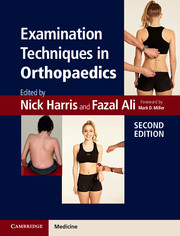Book contents
- Frontmatter
- Dedication
- Contents
- List of contributors
- Foreword
- Preface
- Acknowledgements
- 1 General principles of orthopaedic clinical examination
- 2 Examination of the shoulder
- 3 Examination of the elbow
- 4 Examination of the wrist
- 5 Examination of the hand
- 6 Examination of the peripheral nerves in the hand and upper limb
- 7 Examination of the adult spine
- 8 Examination of the hip
- 9 Examination of the knee
- 10 Examination of the foot and ankle
- 11 Examination of the brachial plexus
- 12 Orthopaedic examination techniques in children
- 13 Examination of the spine in childhood
- Index
- References
9 - Examination of the knee
- Frontmatter
- Dedication
- Contents
- List of contributors
- Foreword
- Preface
- Acknowledgements
- 1 General principles of orthopaedic clinical examination
- 2 Examination of the shoulder
- 3 Examination of the elbow
- 4 Examination of the wrist
- 5 Examination of the hand
- 6 Examination of the peripheral nerves in the hand and upper limb
- 7 Examination of the adult spine
- 8 Examination of the hip
- 9 Examination of the knee
- 10 Examination of the foot and ankle
- 11 Examination of the brachial plexus
- 12 Orthopaedic examination techniques in children
- 13 Examination of the spine in childhood
- Index
- References
Summary
History
General questions
Usually patients present with a combination of symptoms relating to pain, swelling, locking, clicking and giving way; these form the basis of the specific questions asked on taking a history. The diagnostic specificity of each of these symptoms in isolation is poor; rather they are used in combination to guide the examiner to a differential diagnosis. In addition, the presence and degree of each of these symptoms at presentation and how they have changed with the passage of time is important.
It is then important to ascertain the duration of symptoms, exact details of the mechanism of injury and then the general course of events, including response to any treatment already received. It is through this aspect of the history that one obtains a clear picture of the degree of disability suffered by the patient.
Other key questions include occupation, sport and lifestyle.
Specific questions
Pain
The site of pain within the knee is an indication as to the structure damaged but is by no means diagnostic, particularly with traumatic disorders such as meniscal tears. As an example, lateral joint pain from a patellofemoral disorder is frequently mistaken for a lateral meniscal tear. The site of pain following an episode of injury, however, such as a medial collateral ligament (MCL) strain, is a clear indication of the possible structures involved. It is useful to obtain a description of the pain at the time of injury or presentation and then how the pain has progressed. Of particular importance is whether the pain is constant and whether it occurs at night. For instance, these symptoms are an indication to recommend arthroplasty in assessing a patient with severe degenerative changes. Constant pain may indicate more sinister pathology such as tumour or infection.
- Type
- Chapter
- Information
- Examination Techniques in Orthopaedics , pp. 118 - 132Publisher: Cambridge University PressPrint publication year: 2014



